Personalized/Blended-based eLearning
Overview
Over the past fifteen years educators have realized the need to “reinvent” the US k-12 classroom. The tradition “one size fits all” method of education has been blamed for the alarming lack of motivation in US high schools. A rapidly changing world necessitates education become motivational at an equally swift pace, as students need to be equipped with an ever-broadening knowledge base to prepare them for their post-K-12 lives.
The goal of Personalized Learning is to tailor lessons for individual students that will motivate them to master content on their own schedule, whether it’s faster or slower than their same-age peers. At its most extreme, personalized learning can also motivate kids to study whatever they’re most interested in, although experts say most schools still require students to cover key subjects and skills by using personalized motivational materials (see: Integrated Personalized Learning).
Personalized, Blended, Project-based learning dates back to turn of the twentieth century when John Dewey first came up with student-centered learning concepts. This progressive model lost favor during the Great Depression but had a renaissance after WWII only to lose favor again during Sputnik; it came back into favor only to be shoved aside again during the No Child Left Behind years. Because of technology this pedagogical methodology now has a chance to reach it’s full potential.
Competency-based Learning
Another vestige of the personalized learning movement is the competency-based teaching and learning platform. There are many types of competency-based education (CBE) programs, and there is currently no Federal definition for these educational methods. However, in general, a CBE program is one that organizes content according to what a student knows and can do, often referred to as a “competency.” CBE programs also generally have very clear claims for student learning, stress what students can do with the knowledge and skills they acquire, and have assessments that provide measurable evidence of competency. (see: Competency-based Learning).
In competency-based learning students are graded and receive credit for the of “mastery of material” rather than the certain number of hours completed in the classroom. Students earn credit for skills learned through internships, community service, independent study, performing arts groups and on-line courses. This platform is also known as Extended Opportunity-based Learning or EOLs.
Blended-based Learning
The Blended-based Learning model refers to any progressive teaching/learning methodology which combines traditional K-12 teaching methods with innovative programs to encourage the development of the so called “soft skills” of critical thinking, collaboration and communication. “Flip Teaching” and the “FIZZ Project” are two examples of these pedagogical methodology supplements. Another is the Buck Institute for Education’s Project-based Learning program which augments traditional curriculum with student projects that are designed to resemble work-place problem solving. Blended-based Learning is one of several progressive teaching platforms being integrated into the Common Core Initiative (see: K-12 Learning and Teaching Platforms).
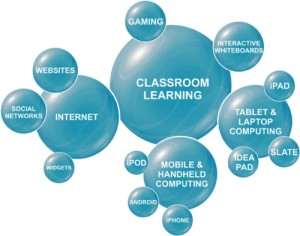 The William and Flora Hewlett Foundation has given the National Association of State Boards of Education (NASBE) a three-year grant of approximately $774,000 to help state boards to encourage exploration of deeper learning. The NASBE is embarking on an effort to go beyond policies that expand the breadth of learning to develop student expertise in critical thinking, problem solving, effective communication, collaboration, and self-awareness (see the following article NASBE Initiative Delves into Deeper Learning).
The William and Flora Hewlett Foundation has given the National Association of State Boards of Education (NASBE) a three-year grant of approximately $774,000 to help state boards to encourage exploration of deeper learning. The NASBE is embarking on an effort to go beyond policies that expand the breadth of learning to develop student expertise in critical thinking, problem solving, effective communication, collaboration, and self-awareness (see the following article NASBE Initiative Delves into Deeper Learning).
Flip Teaching
Flip teaching (or flipped classroom) is a form of “Blended-based Learning” which encompasses any use of technology to leverage the learning in a classroom, so a teacher can spend more time interacting with students instead of lecturing. This is most commonly being done using teacher-created video lectures that students view outside of class time. It is also known as “the backwards classroom,” reverse instruction,” flipping the classroom,” and “reverse teaching.”
The traditional pattern of teaching has been to assign students to read a section of a textbook after-school, which will then be discussed the next  day in class. Student would then be assigned a homework assessment to demonstrate their mastery of the topic. In flip teaching, the student first studies the topic by himself, typically using video lessons created by the instructor or shared by another educator, such as those provided by the Khan Academy. In the classroom, the pupil then tries to apply the knowledge by solving problems and doing practical work. The role of the classroom teacher is then to tutor the student when they become stuck, rather than to impart the initial lesson. This allows time inside the class to be used for additional learning-based activities, including use of “differentiated instruction” and “project-based learning.”
day in class. Student would then be assigned a homework assessment to demonstrate their mastery of the topic. In flip teaching, the student first studies the topic by himself, typically using video lessons created by the instructor or shared by another educator, such as those provided by the Khan Academy. In the classroom, the pupil then tries to apply the knowledge by solving problems and doing practical work. The role of the classroom teacher is then to tutor the student when they become stuck, rather than to impart the initial lesson. This allows time inside the class to be used for additional learning-based activities, including use of “differentiated instruction” and “project-based learning.”
Flip teaching allows more hands-on time with the instructor guiding the students, allowing them to assist the students when they are assimilating information and creating new ideas (upper end of Bloom’s Taxonomy).
History of Flip Teaching
Some of the earliest work in this field was done by Eric Mazur at Harvard, who developed “Peer Instruction” in the 1990s. Professor Mazur found that computer aided instruction allowed him to coach instead of lecture. He wrote “As a result, my teaching assistants and I can address several common misconceptions that would otherwise go undetected. I believe that we are just seeing the beginning of the process and the computer will soon become an integral part of education. Computers will not replace teachers, but they will certainly provide them with an important dynamic tool for improving the quality of education.”
Maureen Lage, Glenn Platt and Michael Treglia published the paper “Inverting the Classroom: A Gateway to Creating an Inclusive Learning Environment,” in 2000. They discussed flip teaching (called “Inverted Instruction” or “Inverted Classroom”) in introductory economic courses at Miami University. The authors emphasized how flip teaching enablesdifferentiated instruction to accommodate a variety of student learning styles, although neither “flip teaching” nor “differentiated instruction” was referenced by those names.
J. Wesley Baker presented the paper “The classroom flip: using web course management tools to become the guide by the side,” in 2000 at the 11th International conference on College Teaching and Learning. It has been quoted many times since, with the catch phrase “become the guide on the side” instead of the “sage on the stage” – the mantra of the classroom flipping movement. In it, Baker presents the model of classroom flipping where teachers use online web tools and web course management programs to present instruction online as the student “homework” assignment. In class, then, teachers have time to move more in-depth with active learning activities and collaborative efforts with other students.
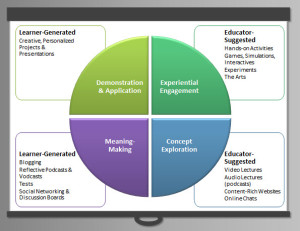 Starting in fall 2000, the University of Wisconsin-Madison started using eTeach software to replace lectures in a Computer Science course with streaming video presentations that combined video of the lecturer with coordinated PowerPoint slides. Having lectures online allowed students to watch lectures when they had time on their schedule and when they felt the most attentive and focused. It also allowed students and professors to spend class time on problem solving, increasing interaction between students and their instructors.
Starting in fall 2000, the University of Wisconsin-Madison started using eTeach software to replace lectures in a Computer Science course with streaming video presentations that combined video of the lecturer with coordinated PowerPoint slides. Having lectures online allowed students to watch lectures when they had time on their schedule and when they felt the most attentive and focused. It also allowed students and professors to spend class time on problem solving, increasing interaction between students and their instructors.
In 2004, Salman Khan began to record videos at the request of a younger cousin who felt that if the lessons were recorded she could skip through parts she had mastered, yet replay other parts that were troubling her to learn. Khan’s model is to essentially provide tutoring on a one-to-one basis. Recently, Khan Academy videos have been used by some educators as part of their flipped teaching strategy.
In the presentation “The Classroom Flip” (2006), authors Mike Tenneson and Bob McGlasson demonstrate which choices teacher should make when considering flipping their classrooms. In particular, teachers need to ask questions about what they most want to change in their classrooms and the presentations helps to determine how flipping using different mechanisms can enhance the teaching process for that individual. This presentation presents the reasons that learners can grow more given the well-planned lessons and activities as it relates to learning theory and motivation. It also explores different forms of computer course management systems that may be chosen.
Jeremy Strayer’s 2007 doctoral dissertation, “The effects of the classroom flip on the learning environment: a comparison of learning activity in a traditional classroom and flip classroom that used an intelligent tutoring system,” considered the flipped or inverted classroom in the university setting. The author taught Statistics and Pre-Calculus courses in which he videotaped himself giving introductory lessons that he then assigned for homework. Students then did engaging project work in class, and the courses involved use of in-class activities as well as Blackboard interactive technology. The author believed that students would control when they watched the video, thus they would be most likely to be alert and able to take in new information.
Woodland Park High School chemistry teachers Jonathan Bergmann and Aaron Sams have been driving forces in flip teaching in secondary education since 2007. Bergmann believes that the biggest impact of flip teaching in his classroom is to increase human contact. Wikipedia
The Fizz Project Friday Institute for Education Innovation
FIZZ is a project of the Friday Institute for Educational Innovation which part of the North Carolina State University College of Education. Developed by Dr. Lodge McCammon the 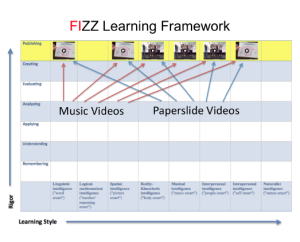 FIZZ project goals are to develop innovative teacher professional development practices and resources to improve 21st Century teaching and learning. To provide professional development to schools in order to transform teaching and learning by focusing on publishing “one take videos.”
FIZZ project goals are to develop innovative teacher professional development practices and resources to improve 21st Century teaching and learning. To provide professional development to schools in order to transform teaching and learning by focusing on publishing “one take videos.”
Classroom engagement is at the core of student success. Ask any adult to name their favorite teacher and receive the profile of a person who inspired learning and became a legend in the mind of their students. But how can we teach someone to be engaging? Well, we need to give them the ideas and tools that allow engagement to occur by creating super-transparent classrooms that highlight exciting and authentic teacher and student work. Suddenly you will have a class of students on the edge of their seats (and out of their seats), willing to learn anything, and excited about what they will create next. There’s a new way of teaching that is taking all the 21st century elements that people talk about, and is putting them into action. Video recording, Web 2.0, online publishing and interactive curriculum are the wave of the future—and the method of teaching that will bring our teachers, students and classrooms there is called FIZZ. FIZZ will be an ongoing service offered and managed by the Friday Institute.
In a nut shell FIZZ develops teaching programs that fall into the Blended-based Learning Model. As shown on their FIZZ Learning Framing Chart Bloom Revised Taxonomy’s hierarchy of learning is on the left hand side vertical axis. It is arranged from lower order thinking skills to higher order thinking skills from “Remembering” to “Creating” with one more level added called “Publishing.” In descending order they are:![bloom-interactive-pyramid-12ta9bt[1]](http://i-pel.org/wp-content/uploads/2014/02/bloom-interactive-pyramid-12ta9bt1-300x191.jpg)
- Publishing
- Creating
- Evaluating
- Analyzing
- Applying
- Understanding
- Remembering
The focus is on creating new products and ideas with the students in the classroom and if they are assigned to publish those new products and ideas they are going to take that assignment much more seriously. This also adds another level of rigor to each assignment. The publication is done in a format called “One-take Videos.” This way they can revisit the video to re-evaluate and re-analyze not only what they create but also what their peers create. These are the powerful lessons that are going to engage the student.
By videotaping their response to the lesson they are actually “teaching” the lesson all over again. By learning the lesson well enough to teach it requires the student to “own” the subject matter. By doing this they are “creating” their own lesson which is one of the highest orders of thinking skills.
Along the horizontal axis are got eight multiple intelligences and learning styles. In any classroom you have a very diverse group of students who all learn in different ways and all have different strengths. These learning styles are: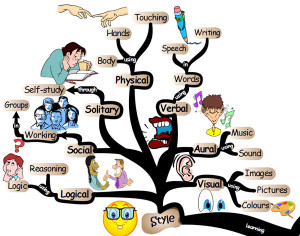
- Linguistic intelligence (“word smart” they learn by writing and reading)
- Logical-mathematical intelligence (“number/reasoning smart)
- Spatial intelligence (“picture smart” they learn from images)
- Bodily-Kinesthetic (“body smart” they have to be moving around to learn)
- Musical intelligence (“music smart” they learn by listening to or creating music)
- Interpersonal intelligence (“people smart” they students are the collaborators they work well with other people)
- Intra personal intelligence (“self-smart” they student work best by themselves)
- Naturalist intelligence (“nature smart” work best when interacting with nature)
The goal is to create lessons that hit as many of these learning styles as possible so we obtain the highest level of rigor that we can offer our students. That is “creating” and “publishing” so these students are really engage in the process of learning.
Many times where we are in our schools we bring the students in they sit quietly and we deliver information to them we lecture to them. We then send them home to apply that information. This is what we are offering our students with that situation – we are focusing on linguistic learners we’re expecting them to remember and understand what we tell them and them go home and maybe answer some questions out of the book or work on a worksheet so apply the information at home.
FIZZ is about creating strategies, materials and ideas so that we can “bubble-up” (FIZZ) from the bottom to get activities in class that result in these types of lessons (one-take videos). We want to “FIZZ-up” so that everyday students are creating and publishing so they can reflect, re-evaluating and reanalyzing what they are creating and be really engaged and excited about the processes of learning.
The FIZZ professional development is all about transforming education and the way we are going to do that is by “flipping” the classroom. And the way we are going to do that is by using this “one-take video” strategy. We are going to have teachers film their lectures so the students can watch those lectures outside of class so when they come into class we are using differentiation in the classroom by allowing students to collaborate, create and publish every day. That’s going to be an engaging and exciting classroom environment. (see: The Fizz Project)

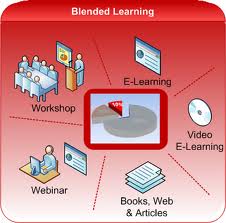
Recent Comments